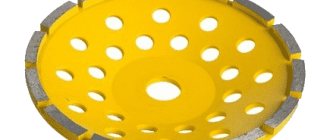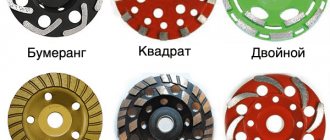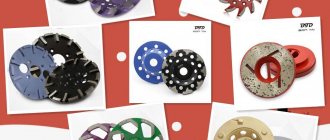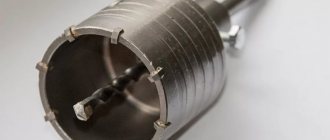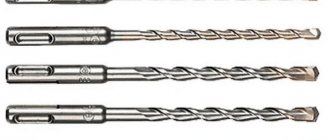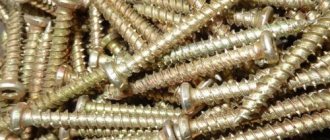Grinding the screed after pouring is a necessary procedure used to level the surface. When processing, special equipment is used - a diamond cup for concrete. Grinding work allows not only to prepare the screed for subsequent coating, but also to strengthen it by removing from the surface the fragile top layer on which cement laitance appears.
Scope of application
The high reliability and wear resistance of the diamond cup make it unrivaled among other equipment for processing hard materials. Using the nozzle, you can scrape and grind concrete, brickwork, stone slabs, porcelain tiles, and paving slabs. Diamond discs are widely used for polishing natural stone - marble or granite. Operations performed using discs include rough, profiled and finishing grinding operations. Diamond cups are used for the following purposes:
- removal of screed sagging;
- roughening;
- alignment of seams;
- grinding joints;
- surface cleaning;
- removal of old or protruding layer;
- final polishing.
When installing attachments on an angle grinder, a dust extractor is usually used or the surface to be treated is moistened with water (wet grinding). This will help reduce dust and make cleaning easier.
Concrete grinding discs are widely used during dismantling work. They effectively remove layers of used glue, hard-to-remove coatings (epoxy, plaster, plaster) and have a long service life. Grinding with a diamond cup saves time: it not only removes unnecessary layers, but also immediately levels the surface.
Diamond blades for grinding concrete floors
First, you should decide on the work ahead and understand what kind of disk is needed, because the quality of the work done and the time spent on the entire process directly depend on the correct choice. Diamond blades vary in shape into segmented, solid, combined and grinding. In addition to their shape, they are divided into hard and soft. The first option is used for cutting lightweight concrete (reinforced) and bricks.
- Segmented diamond wheels for dry cutting are suitable for processing ceramics, stone, bricks, granite and other hard materials. They cannot be used for cutting metal only. Here, the abrasive disc is designed so that it heats up slowly during the cutting process, which increases the work time. Manufacturers recommend using the segmented disc on the stone within 1-1.5 minutes, then it must be cooled for approximately 30 seconds.
- Solid diamond blades for wet cutting. These products are characterized by the fact that they have no cutouts, which allows you to make even cuts. Such discs are used for cutting fragile materials: glass, ceramics, marble. During operation, the disk heats up very quickly because it has a wide strip of diamond coating on it. To cool it down. Often water is used, so the material will not melt.
- Combined diamond blades are versatile because they can be used to cut different materials, both brittle and hard.
- Sanding discs. This type can be flat or with a slightly concave middle. This is a flexible disk that performs stripping work; it can be used to easily and quickly remove old coating.
This video shows how to properly grind concrete with your own hands:
average rating 0
more than 0 ratings
Share link
Comments
Mikhail 08.08.2018 16:55
Good afternoon. Please tell me which bowl is best to use for grinding a concrete industrial floor with a reinforcing top layer - “TOPPING”, for further application of a polymer coating? As you know, Topping sands very poorly.
Design features
Cups for concrete are made of hardened steel with fused small fractions of diamonds. The nozzle is a product consisting of the following elements:
- Round concave base with elements for installation on high-speed electric tools.
- A grinding wheel for concrete, on which segments with diamond fractions are fused.
The bowl-shaped base has holes for cooling during operation. Diamond cutters are located in a circle on the working circumference of the disk, separated by certain intervals (slots). The slots also help cool the cup with air and, in the case of wet processing, with water.
The diamond cup for grinding concrete is attached to the spindle of the grinder using a nut; for this purpose, there is a special hole in the center of the base. Some models have a thread, and the tool can simply be screwed onto the shaft.
Main characteristics
Attachments for grinders vary in size. The most popular standard cup diameter is 125 mm. Other options include diameters from 110 to 180 mm. The power of the tool used to work with the cup must be at least 1500 W. Large nozzles significantly speed up surface treatment, but their cost is higher and they require the use of a more powerful unit. Small-sized products are used by engravers to process workpieces. The diameter of the mounting hole located at the base of the cup varies from 19 to 22.2 mm.
Working elements - cutters - are produced with the addition of small fractions of diamonds to the metal alloy. The mixture is pressed in special forms, which gives it special strength. Large diamond grains (200/160 or 160/125 microns) are used for the manufacture of cutters used for rough processing of concrete surfaces, or roughing. Fine and medium fractions (125/100 and 100/80 microns) are used in the production of finishing attachments.
The advantages of diamond grinding cups for concrete include:
- high strength;
- efficiency;
- durability;
- ease;
- balance.
Builders consider the ability to use a cup without using water to be especially important. The nozzles have special holes on the base that remove air and prevent overheating.
Standard sizes
Concrete grinding disc 125 is a circle of metal onto which cutting parts (segments) are soldered. To fix the diamond powder on the segments, a special binder is used - a substance that connects the individual grains together. This bond may be ceramic, metallic or organic. The main task of the bond is to hold the diamond coating, which is subject to the centrifugal force that occurs when the tool rotates. Diffusion sintering is used to connect the diamond layer to the metal body.
The drive designation contains three parameters:
- disk diameter, mm;
- cutting width (working fluid thickness), mm:
- bore diameter, mm.
For example, the designation of the HILTI DC-D 125/22 UP disk is deciphered as follows: 125 is the diameter of the circle, 22 is the diameter of the mounting hole. In this case, the width of the cut is not specified. This means that it is minimal. Mentioning cutting width is usually a marketing ploy. The manufacturer wants to emphasize that his tool is wider and, therefore, stronger. But, in fact, this does not correspond to reality.
Criterias of choice
It can be quite difficult for non-professionals to choose the appropriate grinding tool for their current tasks. To correctly solve this problem, you need to take into account:
- type of material being processed;
- planned grinding depth;
- parameters of the disk itself: number of segments, diameter, rotation speed.
For private construction, concrete grinding disc 125 is most often used, the price of which varies over a fairly wide range and depends mainly on the manufacturer.
Discs with a diameter of 125 are designed for the simplest and most low-power home angle grinders
Dimensions
Dimensions are regulated according to GOST 10110–87:
- The thickness of the diamond layer is 5 or 10 millimeters and is measured in the radial direction.
- Height. The thickness of the disc body ranges from 0.15 to 2.4 millimeters.
- Seat (inner diameter). The standard value varies from 12 to 76 millimeters. For cutting reinforced or ordinary concrete, a circle with a seat of 20 millimeters is more suitable than others.
- The outer diameter ranges from 50 to 500 millimeters. The step between adjacent cuts in the range of 50-200 millimeters is 25 millimeters, and in the range of 200-500 the step is 50 millimeters. Typically, concrete is processed with circles with a diameter of 115–500 millimeters.
The ratio of dimensions, which are approved by GOST, ensures reliability and strength.
But it is stipulated that the circles can have a height and internal diameter that are not included in the standard size range. Particularly popular these days are products with a seat size of 22.2 millimeters, as well as 25.4. There are hard and soft discs depending on the hardness of the binding material. Soft ones are intended for hard materials (reinforced concrete and concrete). They have a relatively small resource, but cutting is carried out much faster. Hard ones are intended for soft materials such as asphalt, fireclay, clinker, marble.
Price
Approximate prices of diamond blades from different manufacturers:
| Disc diameter, mm | Manufacturer | Cost, rub |
| 115 | Luga Nova | 90-120 |
| Hilti | 280-340 | |
| Bosch | 480-620 | |
| 125 | Luga Nova | 90-195 |
| Hilti | 280-400 | |
| Bosch | 750-1200 | |
| 150 | Luga Nova | 90-220 |
| Hilti | 450-550 | |
| Bosch | 840-1200 | |
| 200 | Luga Nova | 280-350 |
| Hilti | 450-700 | |
| Bosch | 900-1400 | |
| 230 | Luga Nova | 300-400 |
| Hilti | 650-840 | |
| Bosch | 1400-2700 | |
| 250 | Luga Nova | 450-800 |
| Hilti | 1250-2900 | |
| Bosch | 3500 |
The advantage of diamond blades is their wear resistance and strength, as well as the accuracy and high quality of the cut. When using this tool, chips and burrs do not form, even when processing such a durable and porous material as concrete.
Types of Diamond Cups
According to the manufacturing method, the following types of diamond cups for concrete are distinguished:
- Single row
- Double row
- With continuous sintered diamond layer
Single-row nozzles are characterized by low weight and good performance. Used for final polishing of concrete and creating a smooth edge. A small disadvantage is the difficulty of holding the tool on the surface when diamond grinding concrete.
Double-row discs are used for primary processing of concrete and elimination of visible screed defects. Cups with a circular layer of diamond chips are used for polishing natural stone.
Shape and number of segments
The quality of the work performed depends on the type and number of segments. There are cups for roughing, rough grinding and for fine polishing of surfaces. According to the shape of the cutters, the nozzles are classified into the following types:
- With double segment
- Square
- Boomerang
- Turbo
- Typhoon
The design of each type provides for a specific arrangement of segments, which affects its operating properties.
Double segment
The Double Segment Diamond Cup is a two-row tool for eliminating large defects in concrete products. Large beads or protruding seams can be easily sanded with this attachment with a good abrasive effect. Segments arranged in a circle in two rows quickly and efficiently process stone or sandstone. Sometimes builders use a nozzle to reduce a thick layer of screed. But with the help of the “Double Segment” it is impossible to achieve ideal smoothness; the screed becomes rough, so for finishing sanding you need to use a different attachment.
Boomerang
The tool received its name due to the similarity of the shape of the diamond segments to a boomerang. The tool is used for finishing concrete grinding, since the cutters use fine-grained diamond chips. After processing, the screed becomes perfectly smooth. The small weight of the “Boomerang” makes it easy to use; it is often installed on an angle grinder because it is light in weight. The popularity of this type of cup is due to its high productivity, which is almost twice that of other types of diamond blades. The choice of this particular tool is also influenced by its lightness and stability.
Square
Diamond cups “Square” are used for roughening concrete surfaces. The effectiveness of the tool allows it to be used to remove large sagging and protruding seams. Diamond cutters are made in the form of squares. The increased thickness of the working segments and the large distance between them make it possible not only to level the surface with roughness, but also to remove any protruding parts on the concrete. Therefore, grinding with the “Square” attachment reduces the time for rough processing of concrete and brick coatings, extending the life of the diamond segments.
Discs for grinding concrete “Square” are heavy, making it possible to process the material with the tool without much effort.
After passing through the diamond cup, the surface remains rough, which gives it high adhesive properties. This is especially important for adhesion to applied coatings, especially polymer ones.
Turbo and Typhoon
The diamond cutters of these attachments are located in a circle on the working surface perpendicular to the direction of rotation. The minimum distance between them creates an almost continuous ring. The appearance of “Turbo” and “Typhoon” disks resembles corrugated fabric. Many segments smoothly polish the surface, so the products are used for finishing grinding of concrete screeds in small areas and for shaped stone processing. Using attachments, you can chamfer and form edges, as well as polish small curves on workpieces.
To perform small operations, you can purchase “Turbo” and “Typhoon” cups of small diameter – from 100 mm. The discs are characterized by wear resistance, high productivity and precision processing.
Grinding tools
Today, grinding tools are offered by foreign and domestic manufacturers. Their price directly depends on the power of the tool and the manufacturer. To make the concrete floor even, an industrial grinding machine and a grinder are used, into which a diamond polishing bowl is inserted. Let's talk more about these tools.
- Industrial grinding equipment. Such machines are heavy and large, so they are inconvenient to use at home. And the price of such equipment is high, so purchasing an expensive unit for single use is impractical. The industrial grinding machine is multifunctional; it can be equipped with a dust collector, speed controller, and water supply system. The main components of such a tool are a circle and auxiliary wheels on which diamond bits are located. During operation, the nozzles rotate, performing high-quality grinding of the concrete floor.
Industrial grinding equipment
- A grinder is suitable for working at home. If such a tool is compared with an industrial machine, then, of course, the grinder is less productive, but it is optimal for home use. The grinder is also used in production, because it can be used to sand hard-to-reach areas of the floor where a bulky industrial machine cannot penetrate. The main element of a grinding machine is a disk, which can have different diameters. The larger it is, the higher the load on the device. To grind a concrete floor, use a diamond bowl and several attachments.
Attention! When grinding a concrete floor, it is important to monitor how the diamond disk attachment behaves, because it can jump off the mount and injure a person nearby.
How to choose a diamond cup
To produce high-quality processing of a stone or concrete surface, you should carefully consider the choice of a diamond cup. Depending on the type of planned work, the diameter of the nozzle is selected - from 110 to 180 mm. To process small areas where careful sanding is necessary, you need to choose a small cup size. The greatest demand is for 125 mm concrete discs. There are nozzles with a diameter of more than 200 mm. Processing concrete with the help of such a cup is much faster. However, it should be remembered that as the diameter increases, the price also increases.
In accordance with GOST, the diameter of the mounting hole varies from 19 to 22.2 mm. The mounting hole must match the tool that is intended to be used. A loose cup fit can lead to injury and rapid wear of the diamond layer. But usually the attachment kit includes an adapter ring that allows you to use them with tools of different diameters.
All diamond grinding discs for concrete have special markings. It reflects the main characteristics in the following sequence:
- diameter of the outer circle (for example, 125);
- cup depth (40);
- working surface width (10);
- segment height (3);
- mounting hole (22).
All parameters are indicated in millimeters. The brand of diamond powder and the diamond content are specified separately. As a rule, it is 100%, but it can be less or more. Particular attention should be paid to the grain size (for example, 125/100 µm). Large fractions are suitable for rough grinding and roughing work, small fractions are suitable for fine polishing.
The nozzle is selected to match the existing tool. The maximum permissible rotation speed of the disk must correspond to that of an angle grinder, since the safety of work depends on this. Each type of diamond cup has rotation speed restrictions. For example, for double-row cups it is 13,300 rpm.
The weight of the attachment and its balance are also important parameters when choosing a tool. The speed and comfort during surface treatment depends on this.
Attachment and discs for an angle grinder for concrete
Each tool used in conjunction with an angle grinder (angle grinder) is designed to perform the operations for which it is designed. The correct choice contributes to efficient and safe work with discs and attachments.
Cutting discs
Diamond cutting wheels are used to work with concrete. These are discs made of durable hardened steel with diamond coating on the cutting part.
These nozzles differ in the following design features:
- Cutting edge. It can be solid or with various slots. Segmentation increases the efficiency of air cooling during operation.
- The grain size of the diamond coating and the spraying method. The most reliable methods using laser welding and thermal bonding. Silver soldering allows operation with water cooling only. The electroplated diamond edge cuts only soft natural stones.
- The outer diameter of the circle. The correct size disks must be installed. Working without a protective cover is not only dangerous: the increased size of the nozzle leads to premature wear of the gearbox.
Diamond cutting can only cut material in a straight line. Curved sawing increases the load on the cutting edge, causing the diamonds to break.
Grinding discs for concrete
Concrete is ground to eliminate coating defects. Diamond wheels are used, which have a high abrasive ability and a long working life. Sometimes hard-alloy coated disks, the characteristics of which are lower, are called diamond. The efficiency of work is determined largely by the grain size of the working surface.
Depending on the concentration of diamonds, discs for grinding concrete are distinguished:
- grain size 40-80 (for pre-treatment);
- indicators 100-120 (for leveling the surface);
- grit 180-240 (for polishing).
The tool is a steel circle with soldered segments. Diamond powder is fixed to them with a special bond. It keeps the diamonds from being destroyed by the centrifugal force that occurs during rotation.
The designations on the discs consist of 2 or 3 numbers. The first number indicates the outer diameter, the second indicates the size of the mounting hole. The third number is not always present; it indicates thickness. For a grinding tool, this parameter does not play a big role.
Cleaning and roughening attachments
These attachments look like cups or circles. There are cutters and diamond discs. Twisted metal brushes are located around the circumference of the rollers. They strip metal and stone. The diameter of the wire varies depending on the purpose (scraping or stripping).
The working part of the diamond grinding disc has cutting edges. It is not used for stripping metal: it is used to clean stone, concrete, and remove hardened cement mortar.
Purpose of an angle grinder
The peculiarity of the machine is its ability to process not only smooth surfaces, but also chamfers. This is achieved thanks to the angular placement of the working disk.
The device is universal and can be used to perform many jobs:
- The main operation for which an angle grinder is intended is grinding. Wide grinding wheels are used. Processing the ends with an eccentric grinder is difficult, but it is accessible for an angle grinder. The surface is ground with or without water cooling.
- Polishing with a grinder is also possible. To do this, use special diamond-coated polishing discs.
- Another operation that is performed with a grinder is res. The unit is not suitable for working with thick materials. Concrete or thick stone should be cut with special machines that have a water-cooled working wheel.
- An angle grinder easily cleans surfaces, removing dirt, paint, mastics, adhesives, and construction mixtures using abrasive attachments.
A grinder can be used instead of a wall chaser. A cutting disc is used to cut grooves for electrical cables and pipelines.
Purpose of an angle grinder
A grinder, or officially an angle grinder, is an almost universal tool that allows you to perform many operations:
- surface grinding;
- cutting materials;
- cleaning;
- polishing
The main distinctive feature of the angle grinder is the method of installing the spindle, which is installed at an angle to the body. This design allows you to effectively use hand tools as real professional equipment. A variety of materials can be processed with a grinder: wood, stone, brick and concrete.
Features of grinding work
Diamond, as the hardest substance, effectively copes with the most difficult jobs of cleaning and grinding concrete screeds. To perform surface treatment, a diamond alloy cup is attached to the spindle of an angle grinder (grinder). The rotational motion that is transmitted to the disk is approximately 11,000 revolutions per minute. The high power of the tool on which the diamond concrete grinding cup is mounted also increases the productivity of the disc itself.
When working with hard surfaces, consider the following guidelines:
- The correct choice of nozzle in accordance with its purpose will greatly facilitate the processing of concrete.
- Before finishing grinding, rough grinding of edges and sagging is carried out to reduce the load on the disc.
- To break in the cup, it is necessary to carefully break it in in a gentle mode during the first few meters.
- The grinder should be held firmly with both hands to prevent impacts, especially when removing rough protruding defects.
- During operation, the cutter is pressed against the surface, but without increased pressure.
- Do not grind surfaces with breaks or cracks.
- To self-clean the nozzle, effectively cool it and reduce dust formation, it is recommended to supply water to the screed being treated.
- It is strictly not recommended to carry out work during frequent power outages or using faulty tools.
To avoid injury during work, you should use closed shoes made of thick, durable material. Compliance with these simple recommendations will ensure safety during work and extend the life of the diamond cup for construction concrete for an angle grinder.
Safety precautions when working with an angle grinder
To avoid damaging the instrument and harming yourself, you must follow these rules:
- Make sure the angle grinder is in full working order before you begin.
- There must be enough light at the work site.
- The user should wear thick clothing. Sleeves should not interfere with working with the device, and the clothing itself should not be in contact with the floor.
- Care should be taken to protect the respiratory tract, eyes and hands with gloves, a pair of goggles and a respirator.
- You need to let the device rest at least once every 15 minutes to prevent it from overheating.
Educational program: 2 types of jackhammer: features of pneumatic and electric chippers
As you can see, an angle grinder is very useful for concrete. You just need to choose a suitable grinding wheel for it and act carefully.
